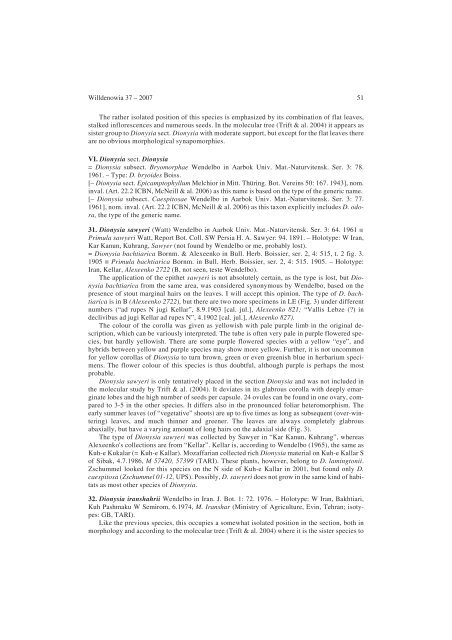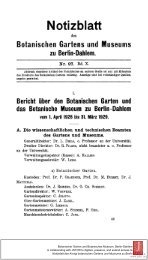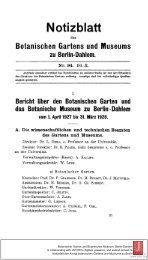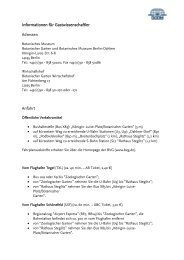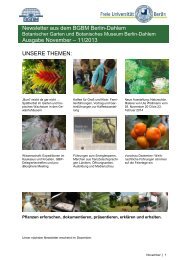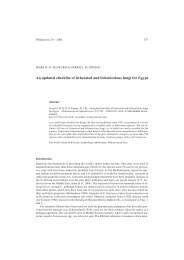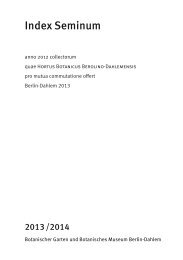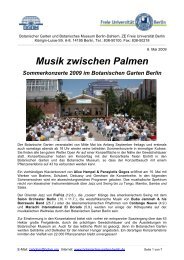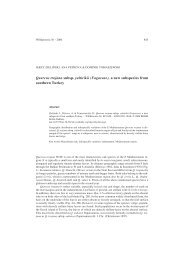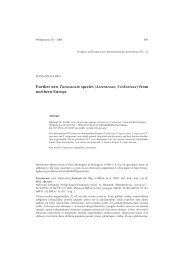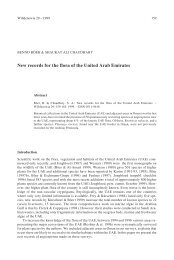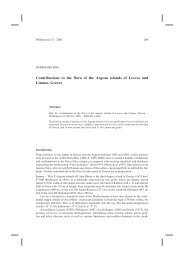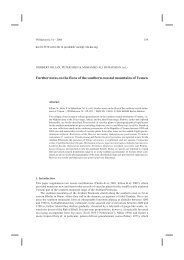The genus Dionysia (Primulaceae), a synopsis and five new species
The genus Dionysia (Primulaceae), a synopsis and five new species
The genus Dionysia (Primulaceae), a synopsis and five new species
You also want an ePaper? Increase the reach of your titles
YUMPU automatically turns print PDFs into web optimized ePapers that Google loves.
Willdenowia 37 – 2007 51<br />
<strong>The</strong> rather isolated position of this <strong>species</strong> is emphasized by its combination of flat leaves,<br />
stalked inflorescences <strong>and</strong> numerous seeds. In the molecular tree (Trift & al. 2004) it appears as<br />
sister group to <strong>Dionysia</strong> sect. <strong>Dionysia</strong> with moderate support, but except for the flat leaves there<br />
are no obvious morphological synapomorphies.<br />
VI. <strong>Dionysia</strong> sect. <strong>Dionysia</strong><br />
= <strong>Dionysia</strong> subsect. Bryomorphae Wendelbo in Aarbok Univ. Mat.-Naturvitensk. Ser. 3: 78.<br />
1961. – Type: D. bryoides Boiss.<br />
[– <strong>Dionysia</strong> sect. Epicamptophyllum Melchior in Mitt. Thüring. Bot. Vereins 50: 167. 1943], nom.<br />
inval. (Art. 22.2 ICBN, McNeill & al. 2006) as this name is based on the type of the generic name.<br />
[– <strong>Dionysia</strong> subsect. Caespitosae Wendelbo in Aarbok Univ. Mat.-Naturvitensk. Ser. 3: 77.<br />
1961], nom. inval. (Art. 22.2 ICBN, McNeill & al. 2006) as this taxon explicitly includes D. odora,<br />
the type of the generic name.<br />
31. <strong>Dionysia</strong> sawyeri (Watt) Wendelbo in Aarbok Univ. Mat.-Naturvitensk. Ser. 3: 64. 1961 ≡<br />
Primula sawyeri Watt, Report Bot. Coll. SW Persia H. A. Sawyer: 94. 1891. – Holotype: W Iran,<br />
Kar Kanun, Kuhrang, Sawyer (not found by Wendelbo or me, probably lost).<br />
= <strong>Dionysia</strong> bachtiarica Bornm. & Alexeenko in Bull. Herb. Boissier, ser. 2, 4: 515, t. 2 fig. 3.<br />
1905 ≡ Primula bachtiarica Bornm. in Bull. Herb. Boissier, ser. 2, 4: 515. 1905. – Holotype:<br />
Iran, Kellar, Alexeenko 2722 (B, not seen, teste Wendelbo).<br />
<strong>The</strong> application of the epithet sawyeri is not absolutely certain, as the type is lost, but <strong>Dionysia</strong><br />
bachtiarica from the same area, was considered synonymous by Wendelbo, based on the<br />
presence of stout marginal hairs on the leaves. I will accept this opinion. <strong>The</strong> type of D. bachtiarica<br />
is in B (Alexeenko 2722), but there are two more specimens in LE (Fig. 3) under different<br />
numbers (“ad rupes N jugi Kellar”, 8.9.1903 [cal. jul.], Alexeenko 821; “Vallis Lebze (?) in<br />
declivibus ad jugi Kellar ad rupes N”, 4.1902 [cal. jul.], Alexeenko 827).<br />
<strong>The</strong> colour of the corolla was given as yellowish with pale purple limb in the original description,<br />
which can be variously interpreted. <strong>The</strong> tube is often very pale in purple flowered <strong>species</strong>,<br />
but hardly yellowish. <strong>The</strong>re are some purple flowered <strong>species</strong> with a yellow “eye”, <strong>and</strong><br />
hybrids between yellow <strong>and</strong> purple <strong>species</strong> may show more yellow. Further, it is not uncommon<br />
for yellow corollas of <strong>Dionysia</strong> to turn brown, green or even greenish blue in herbarium specimens.<br />
<strong>The</strong> flower colour of this <strong>species</strong> is thus doubtful, although purple is perhaps the most<br />
probable.<br />
<strong>Dionysia</strong> sawyeri is only tentatively placed in the section <strong>Dionysia</strong> <strong>and</strong> was not included in<br />
the molecular study by Trift & al. (2004). It deviates in its glabrous corolla with deeply emarginate<br />
lobes <strong>and</strong> the high number of seeds per capsule. 24 ovules can be found in one ovary, compared<br />
to 3-5 in the other <strong>species</strong>. It differs also in the pronounced foliar heteromorphism. <strong>The</strong><br />
early summer leaves (of “vegetative” shoots) are up to <strong>five</strong> times as long as subsequent (over-wintering)<br />
leaves, <strong>and</strong> much thinner <strong>and</strong> greener. <strong>The</strong> leaves are always completely glabrous<br />
abaxially, but have a varying amount of long hairs on the adaxial side (Fig. 3).<br />
<strong>The</strong> type of <strong>Dionysia</strong> sawyeri was collected by Sawyer in “Kar Kanun, Kuhrang”, whereas<br />
Alexeenko's collections are from “Kellar”. Kellar is, according to Wendelbo (1965), the same as<br />
Kuh-e Kukalar (= Kuh-e Kallar). Mozaffarian collected rich <strong>Dionysia</strong> material on Kuh-e Kallar S<br />
of Sibak, 4.7.1986, M 57420, 57399 (TARI). <strong>The</strong>se plants, however, belong to D. lamingtonii.<br />
Zschummel looked for this <strong>species</strong> on the N side of Kuh-e Kallar in 2001, but found only D.<br />
caespitosa (Zschummel 01-12, UPS). Possibly, D. sawyeri does not grow in the same kind of habitats<br />
as most other <strong>species</strong> of <strong>Dionysia</strong>.<br />
32. <strong>Dionysia</strong> iranshahrii Wendelbo in Iran. J. Bot. 1: 72. 1976. – Holotype: W Iran, Bakhtiari,<br />
Kuh Pashmaku W Semirom, 6.1974, M. Iranshar (Ministry of Agriculture, Evin, Tehran; isotypes:<br />
GB, TARI).<br />
Like the previous <strong>species</strong>, this occupies a somewhat isolated position in the section, both in<br />
morphology <strong>and</strong> according to the molecular tree (Trift & al. 2004) where it is the sister <strong>species</strong> to


